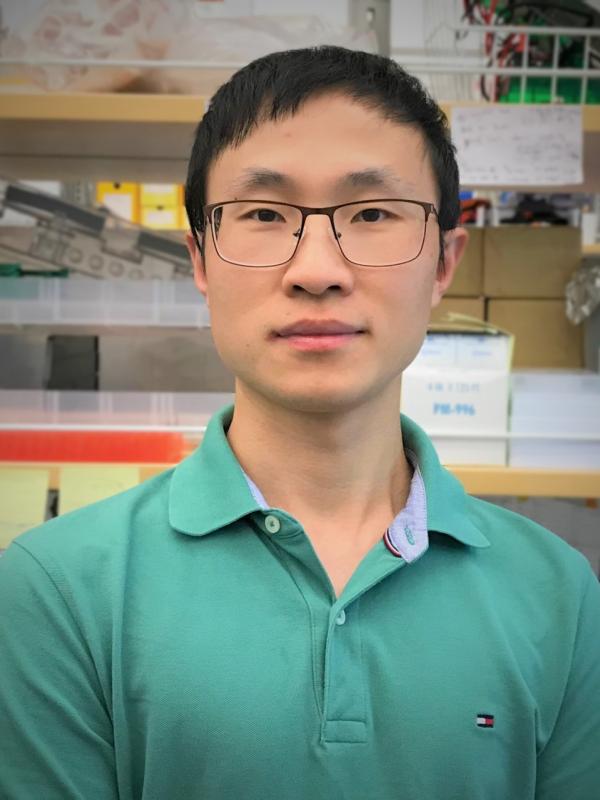
Shuai Huang
Assistant Professor
240A Rightmire Hall
1060 Carmack Rd
Columbus, OH
43210
Areas of Expertise
- Plant Cell-intrinsic Immunity
- Biological Phase Separation
- Evolution of Immune Circuits
Education
- Ph.D.: The University of British Columbia
- Postdoc: Howard Hughes Medical Institute/Yale University
Research Interests
A cell is the basic unit of life. Yet, the inside environment of a cell is extremely crowded. A fundamental question in cell biology is how cells regulate cellular activities within such a crowded environment to fulfill proper functions. A traditional view is that cells compartmentalize biochemical activities and control energy flow through membrane-bound organelles, such as the nucleus, mitochondria, chloroplast and vesicles, etc. Increasing evidence suggests that cells can also form membrane-free structures (termed biomolecular condensates) often through liquid-liquid phase separation (a process similar to oil in water), which creates additional levels of cellular compartmentalization.
The Huang lab focuses on the molecular and biochemical mechanisms of phase-separated assemblies in plant health and disease. There are three main directions of research in the lab: 1) systems approach for a detailed understanding of phase separation control of gene expression; 2) molecular. cellular and biochemical characterization of defense signal flow through membrane-less condensates; 3) bioengineering and synthetic approaches of immune condensates to benefit agriculture and human health.
Publications:
-
Kim, J.H., Castroverde, C.D.M., Huang, S., Li, C., Hilleary, R., Seroka, A., Sohrabi, R., Medina-Yerena, D., Huot, B., Want, J., Nomura, K., Marr, S.K., Wildermuth, M., Chen, T., MacMicking, J.D., He, SY. Increasing the resilience of plant immunity to a warming climate. (2022) Nature 607, 339–344 (2022). https://doi.org/10.1038/ s41586-022-04902-y.
-
Huang, S., Zhu, S., Kumar, P., MacMicking, J.D. A phase-separated nuclear GBPL circuit controls immunity in plants. (2021) Nature. 594: 424–429. DOI: 10.1038/s41586-021-03572-6.
-
Gaudet, R., Zhu, S., Halder, A., Kim, B.H., Bradfield, C., Huang, S., Xu, D., Mamiñska, A., Nguyen, T. N., Lazarou, M., Karatekin, E., Gupta, K., MacMicking, J.D. A human apolipoprotein L with detergent-like activity kills intracellular pathogens. (2021) Science. 373(6552). DOI: 10.1126/science.abf8113.
-
Zhu, S., Bradfield, C., Mamiñska, A., Park, E.S., Kim, B.H., Kumar, P., Huang, S., Zhang, Y., Bewersdorf J., MacMicking, J.D. Cryo-ET of a human GBP coatomer governing cell-autonomous innate immunity to infection. (2021) bioRxiv. DOI: 10.1101/2021.08.26.457804.
-
Huang, S., Meng, Q., Mamiñska, A., MacMicking, J.D. Cell-autonomous immunity by IFN-induced GBPs in animals and plants. (2019) Current Opinion in Immunology. 60:71-80. DOI:10.1016/j.coi. 2019.04.017.
-
Wang, L., Wen, R., Wang, J., Xiang, D., Wang, Q., Zang, Y., Wang, Z., Huang, S., Li, X., Datla, R., Fobert, P.R., Wang, H., Wei, Y., Xiao W. Arabidopsis UBC13 differentially regulates two programmed cell death pathways in responses to pathogen and low-temperature stress. (2018) New Phytologist. 221(2):919-934. DOI: 10.1111/nph.15435.
-
╫Wu, Z., ╫Huang, S., ╫Zhang, X., Xia, S., Li, X. A GYF domain protein regulates plant NLR protein accumulation through translational repression. (2017) eLife. 6:e23684. DOI: 10.7554/eLife.23684. (╫Equal contribution)
-
Huang, S., Balgi, A., Pan, Y., Zhang, X., Du, L., Zhou, M., Roberge, M., Li, X. Identification of methylosome components as negative regulators of plant immunity using chemical genetics. (2016) Molecular Plant. 12(9), 1620–1633. DOI: 10.1016/j.molp.2016.10.006.
-
Huang, S., Chen, X., Zhong, X., Li, M., Ao, K., Huang, J., Li, X. Plant TRAF proteins regulate NLR immune receptor turnover. (2016) Cell Host & Microbe. 19(2), 204-215. DOI: 10.1016/j.chom.2016.01.005.
Highlights in Nature Plants, (March 2016). DOI: 10.1038/nplants.2016.26. -
Huang, S., Monaghan, J., Zhong, X., Lin, L., Sun, T., Dong, O.X., Li, X. HSP90s are required for NLR immune receptor accumulation in Arabidopsis. (2014) Plant Journal. 79(3), 427-439. DOI: 10.1111/tpj.12573.
-
Huang, Y., Minaker, S., Roth, C., Huang, S., Hieter, P., Lipka, V., Wiermer, M., Li, X. An E4 ligase facilitates polyubiquitination of plant immune receptor resistance proteins in Arabidopsis. (2014) Plant Cell. 26(1):485-496. DOI: 10.1105/tpc.113.119057.
-
Huang, Y., Chen, X., Liu, Y., Roth, C., Copeland, C., McFarlane, H.E., Huang, S., Lipka, V., Wiermer, M., Li, X. Mitochondrial AtPAM16 is required for plant survival and the negative regulation of plant immunity. (2013) Nature Communications. 4, 2558. DOI: 10.1038/ncomms3558.
-
Xia, S., Cheng, Y.T., Huang, S., Win, J., Soards, A., Jinn, T.L., Jones, J.D., Kamoun, S., Chen, S., Zhang, Y., Li, X. Regulation of transcription of nucleotide-binding leucine-rich repeat-encoding genes SNC1 and RPP4 via H3K4 trimethylation. (2013) Plant Physiology. 162(3):1694-705. DOI: 10.1104/pp.113.214551.
-
Cheng, Y.T., Li, Y., Huang, S., Huang, Y., Dong, X., Zhang, Y., Li, X. Stability of plant immune-receptor resistance proteins is controlled by SKP1-CULLIN1-F-box (SCF)-mediated protein degradation. (2011) PNAS. 108(35):14694-9. DOI: 10.1073/pnas.1105685108.
-
Woloshen, V., Huang, S., Li, X. RNA-binding proteins in plant immunity. (2011) Journal of Pathogens. DOI: 10.4061/2011/278697.
-
Germain, H., Qu, N., Cheng, Y.T., Lee, E., Huang, Y., Dong, O.X., Gannon, P., Huang, S., Ding, P., Li, Y., Sack, F., Zhang, Y., Li, X. MOS11: a new component in the mRNA export pathway. (2010) PLoS Genetics. 6, e1001250. DOI: 10.1371/journal.pgen.1001250.
